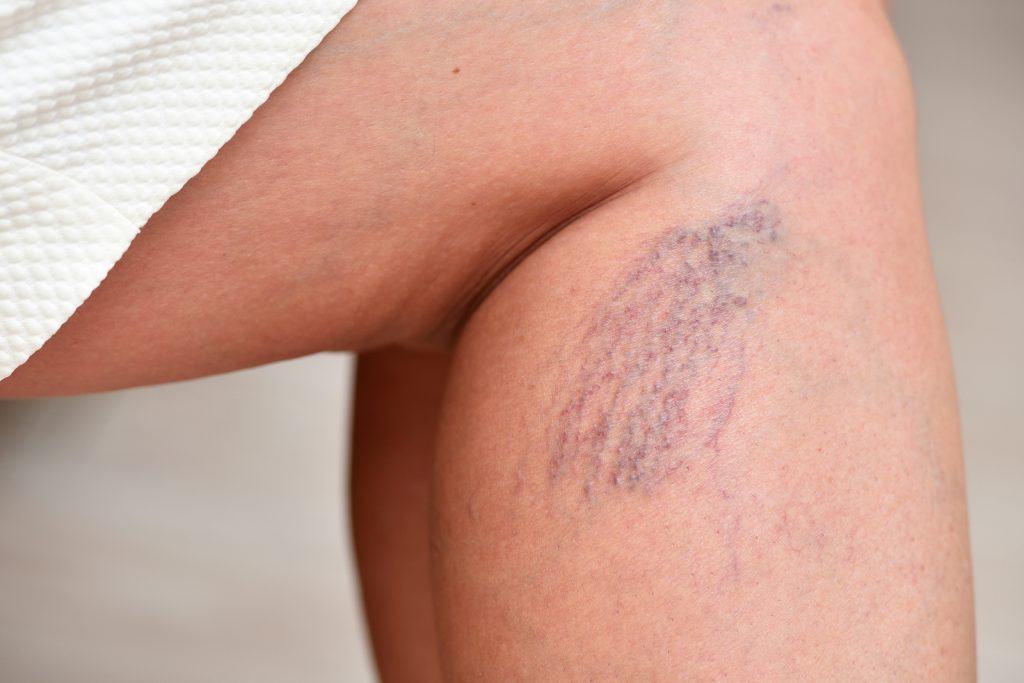
Most people accept that getting older will lead to wrinkles and grey hair, but there are many other physical changes that occur as we age, including developing thread veins.
In fact, these marks, sometimes known as spider veins, are so common that 88 per cent of women and 79 per cent of men experience them in their lifetime, according to Good House Keeping.
So what are they?
Thread veins are small blood vessels, typically blue, purple or red, that appear on the surface of the skin. They are recognisable as they form thin lines, branches or even webs, hence why they are often called spider veins.
According to the British Vein Institute (BVI), they are the result of normal veins that have grown bigger than their usual size.
They most commonly appear on knees, ankles, calves and thighs or cheeks and nose, and even though they are not signs of a serious medical condition, some people might suffer pain, aches and restlessness with them.
What causes them?
One of the main causes of thread veins is age, as the risk of acquiring these blood vessels increases the older you get.
However, they are not just a symptom of aging, and men and women can develop them even in their youth.
Those whose parents have or had spider veins are likely to have them too, as there is a strong genetic link associated with them. According to Medical News Today, nine out of ten people who suffer from these blood vessels do so because they run in the family.
It is also thought they can develop where there has been trauma on the skin, such as surgical scarring, extensive bruising or if fat has been destroyed.
“Thread veins may occur in the region where a minor injury has caused a bruise. Once this has healed, thread veins stay in its place,” the BVI revealed.
Lifestyle factors also play a part, and those who smoke, drink alcohol to excess or are overweight are more likely to have them.
Compression stocking supplier Day Long said smoking and drinking heavily “can lead to problems with poor circulation in the skin”, which could result in spider veins. Similarly, those who have a high body mass index or who do not exercise regularly are also likely to have poor circulation and blood could end up pooling in their legs.
Hormonal changes are also a cause, which is why many women develop them while they are pregnant.
Medical News Today stated: “Increased blood moving through the body in addition to the extra weight of the foetus places more pressure on leg veins during pregnancy. Some women notice that spider veins disappear after pregnancy, but they can be permanent.”
Similarly, hormonal treatments for menopause or birth control could raise the risk of developing these veins, due to the increase in oestrogen.
The majority of people who have spider veins also have varicose veins, with this being the case for 89 per cent of women. This could be the case even if the underlying varicose vein cannot be seen.
Symptoms of spider veins
The main reason why people want to get rid of their spider veins is because they think they are unsightly, and can make sufferers feel self-conscious, particularly if they appear on their face.
However, they are also associated with irritation, such as some itching and minor aching. The BVI notes that mild to severe pain, fatigue and a throbbing sensation can occur sometimes too.
Women might find that symptoms can flare up when they are due their periods because of the hormonal changes in the body.
How to get rid of them
The good news is that spider veins can be easily treated. For instance, wearing compression stockings or socks could help if they appear on the legs, as they place pressure on the veins in the calves and knees, which improves blood flow.
They are also known to reduce swelling, lower the risk of blood clots and relieve aches and pains.
For a more permanent solution, thread vein treatment, such as microschlerotherapy should be considered. This procedure involves injecting a substance into the affected veins. As its consistency is sticky, it closes the vein off from the blood flow, which results in the spider vein being absorbed by the body and disappearing over time. Instead, the blood flows back to the deeper veins.
Several treatments are required to fully get rid of the veins, after which it is essential sufferers do their best to prevent them recurring.
This involves being a healthy weight, regularly exercising, reducing alcohol consumption, wearing compression stockings, avoiding tight clothing, elevating legs when sitting or lying down, wearing sunscreen, being mobile, and not using hot tubs or saunas too much.
For thread vein treatment in Bristol, get in touch with us today.



